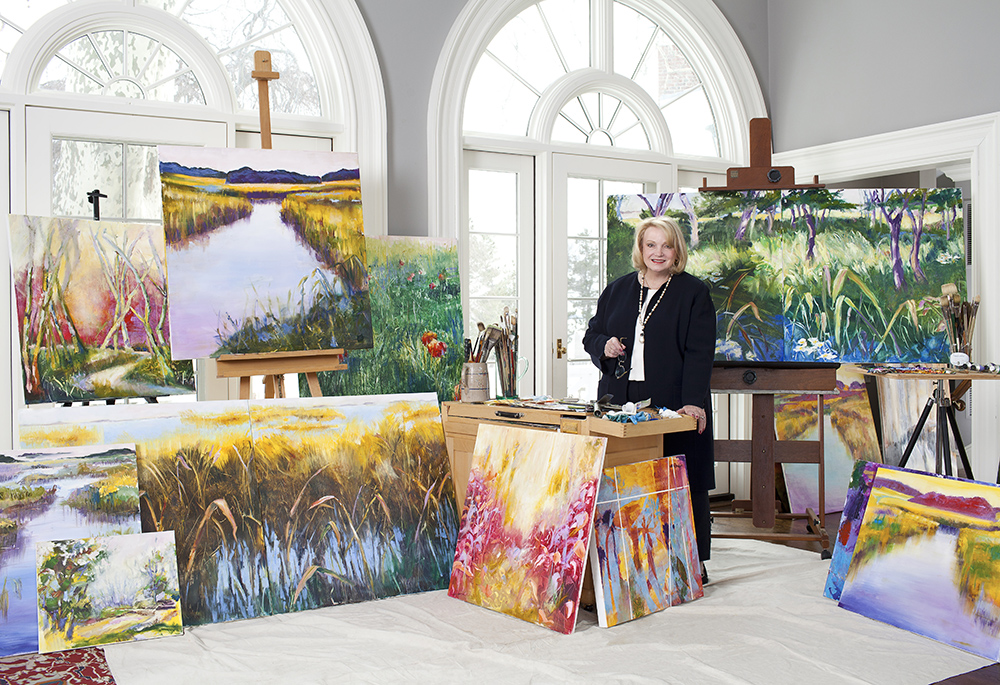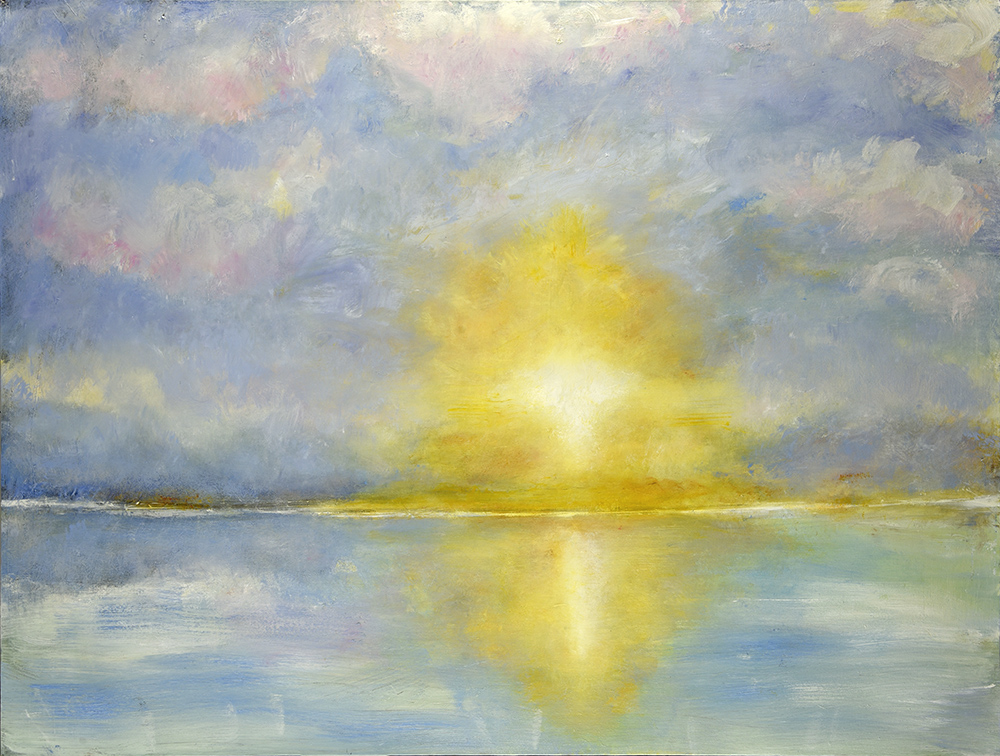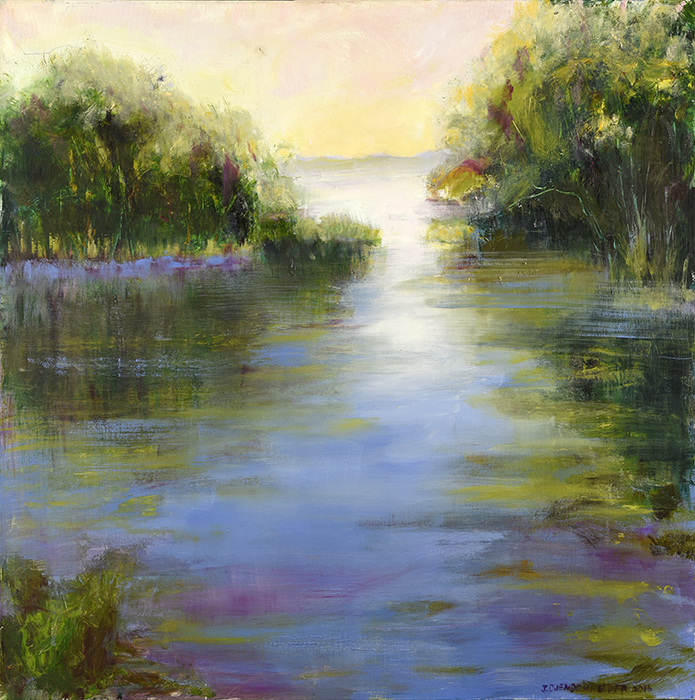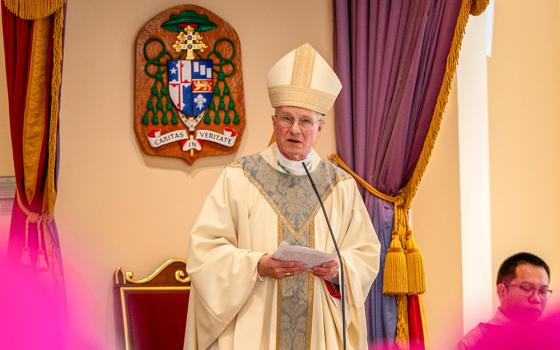
Janet Hennessey Dilenschneider poses with some of her paintings. The artist currently has an exhibit at the gallery of the Sheen Center for Thought and Culture in Manhattan, entitled "Come to the Light." (Courtesy of Sheen Center for Thought and Culture)
"Head towards the light."
I have heard that phrase, or some variation of it, expressed by friends and acquaintances from all walks of life. These include sisters in Ukraine looking for spiritual sustenance during war, to one-time Catholics here in New York who have moved away from the faith but still hold an affirming, optimistic view of light, be it the literal kind or the symbolic type.
Put another way, light as life.
So, it was fortuitous that I was asked recently to see an exhibit of the work of artist Janet Hennessey Dilenschneider at the gallery of the Sheen Center for Thought and Culture in Manhattan.
The current exhibit, "Come to the Light," which runs through June 14, offers art lovers a chance to respond, reflect and recharge — all derived from the power and embrace of light in a collection of 21 oil paintings, both representational and abstract.

"Sunrise, Come to the Light" by Janet Hennessey Dilenschneider (Courtesy of Sheen Center for Thought and Culture)
Noting that we live in a world of turmoil, Dilenschneider seeks to give people "some solace, rest and respite by providing a calm glance at the beautiful world around us," she said in an artist's statement.
The exhibit is relatively small in scale. But the paintings are anything but modest: powerful and arresting, they engage the viewer in a quietly visceral way.
One goal of the exhibit, Dilenschneider's third at the center, is to offer the viewer a kind of "mini-retreat" for the soul and eyes, said MaryLou Pagano, the center's executive director, who recently met me for a gallery tour.
Pagano said that such a retreat is an affirmation of spirituality and faith — though that could be the faith of practicing Catholics, non-practicing "cultural" Catholics or those of other religious traditions.
Advertisement
Pagano notes that Dilenschneider's work is spiritually subtle – you will not find overtly religious elements in this work. But the sense of awe of God's creation that Dilenschneider suggests is hard to miss, Pagano told me as I took in the exhibit.
One such painting is "Sunrise, Come to the Light," which struck me as influenced by the great English painter J.M.W. Turner (1775-1851). Like Turner's work, Dilenschneider's painting, which adorns the cover of the exhibit's catalog, frames the glory of sunrise light amid the striking elements of mist and blue sky.
Another painting, "Sunlight on the Water," seems more influenced, as do several other paintings, by the French Impressionists. In the depiction of a simple scene in which a cove foregrounds a larger body of water, Pagano sees a possible spiritual journey at play.
Blue is present in many of the paintings, and Pagano notes that blue is a "life-giving" color and is often associated with depictions of Mary, the mother of Jesus.

"Sunlight on the Water" by Janet Hennessey Dilenschneider (Courtesy of Sheen Center for Thought and Culture)
Pagano repeated what the artist had said in an exhibit announcement — that the Sheen Center is an appropriate place to host the exhibit, not only because of Dilenschneider's long association with the center, but because the artist shares its mission "of bringing joy and happiness to its patrons."
The center, opened in 2015 as the Archdiocese of New York's official arts center and named after Archbishop Fulton J. Sheen, is located in a lower Manhattan building that originally served as a mission church for Italian immigrants.
In a related statement, Cardinal Timothy Dolan, archbishop of New York, called Dilenschneider "a wonderful friend" who shares "her talents and treasures" with New York's Roman Catholics. Her vision, he said, is "bringing people into the Light!"
For her part, Dilenschneider — baptized as an Episcopalian but who married a Roman Catholic and attends a Roman Catholic church — said that she is inspired by Archbishop Sheen, who once said, "If we wish to have the light, we must keep the sun; if we wish to keep our forests we must keep our trees; if we wish to keep our perfumes, we must keep our flowers — and if we wish to keep our rights, then we must keep our God."
I was fortunate to interview Dilenschneider, who lives in Connecticut, by Zoom a few days after seeing the exhibit. During our nearly hourlong interview, she affirmed the exhibit's desire to offer relief and solace in a world filled with turmoil.
'Color is the joy. Color is where you get the joy of the whole thing.'
—Janet Hennessey Dilenschneider
"I'm not trying to be a psychiatrist or anything, but I feel people should 'come to the light,' " she said, citing Fulton Sheen as an influence. But she also hopes that, as she did a few months ago when she witnessed a glorious sunrise one morning, others can see "the magnificence of the world" as something spiritual.
I asked Dilenschneider about a point made by Pagano and in the exhibit catalog: the importance of color, gesture and texture in her work.
About color, the artist said that if you have "sunlight blue against yellow" you get "simultaneous contrast. One color modifies the other color. You see it differently, physically see it differently than if you put pink and pink and a little more pink and maybe similar colors together or just ones that don't have the 'zing' gesture."
"Color," she told me, "is the joy. Color is where you get the joy of the whole thing."
Gesture, she said, "is the passion" in the creation, while texture adds a finishing touch and depth to the work. With texture, she said, "when you get in close, you see another element. But if I were just to take a painting and not have any of those three emphasized, I think it would be less exciting."
As for the use of the color blue, Dilenschneider said, "I want people to be able to look at something calm, calming, something that will take their mind off of the difficult things" facing the world. "And I think the blue is a way to do it."
But it is never a simple thing. As we spoke, Dilenschneider said that, sitting at a desk and looking out a window toward Long Island Sound, she was witnessing "beautiful blue clouds, white, blue sky and white clouds. And I can hold that feeling. I feel that feeling." She paused. "It's the feeling you get when you put it all together."
'I want to be able to make a statement. I think nature is beautiful. I want people to be able to look at it and see the light in it. See the light that an artist always looks for.'
—Janet Hennessey Dilenschneider
Though representational work has pride of place in the current exhibit, Dilenschneider told me she doesn't favor that work over abstract pieces. Nor does she feel that representational art is a kind of throwback.
She does acknowledge a love of Turner's work — she said she had to be "poured out" of the famed Tate Britain gallery during a London visit because his work is so arresting. And she believes more artists should be interested in light — the kind she sees in Turner's work, which she prizes because of Turner's mastery of depicting mist. Mist, she said, "is mystery."
I wasn't surprised by that, as I sensed both Dilenschneider and Turner both share a sense of awe, as well as mystery. Of course, Turner knew his era was marked by the threats of industrialization — but nothing on the scale the world faces now. In past exhibits, Dilenschneider said, she has hit the theme of ecology "very hard," though in ways that are subtle, and focus more on the "spiritual quality that art can have, the healing quality."
That carries over into the current exhibit. "I want you to fall in love with nature all over again," she said, speaking of those encountering her work.
"I want to be able to make a statement. I think nature is beautiful. I want people to be able to look at it and see the light in it. See the light that an artist always looks for."
Because as Janet Hennessey Dilenschneider reminds us, where there is light, there is life.





